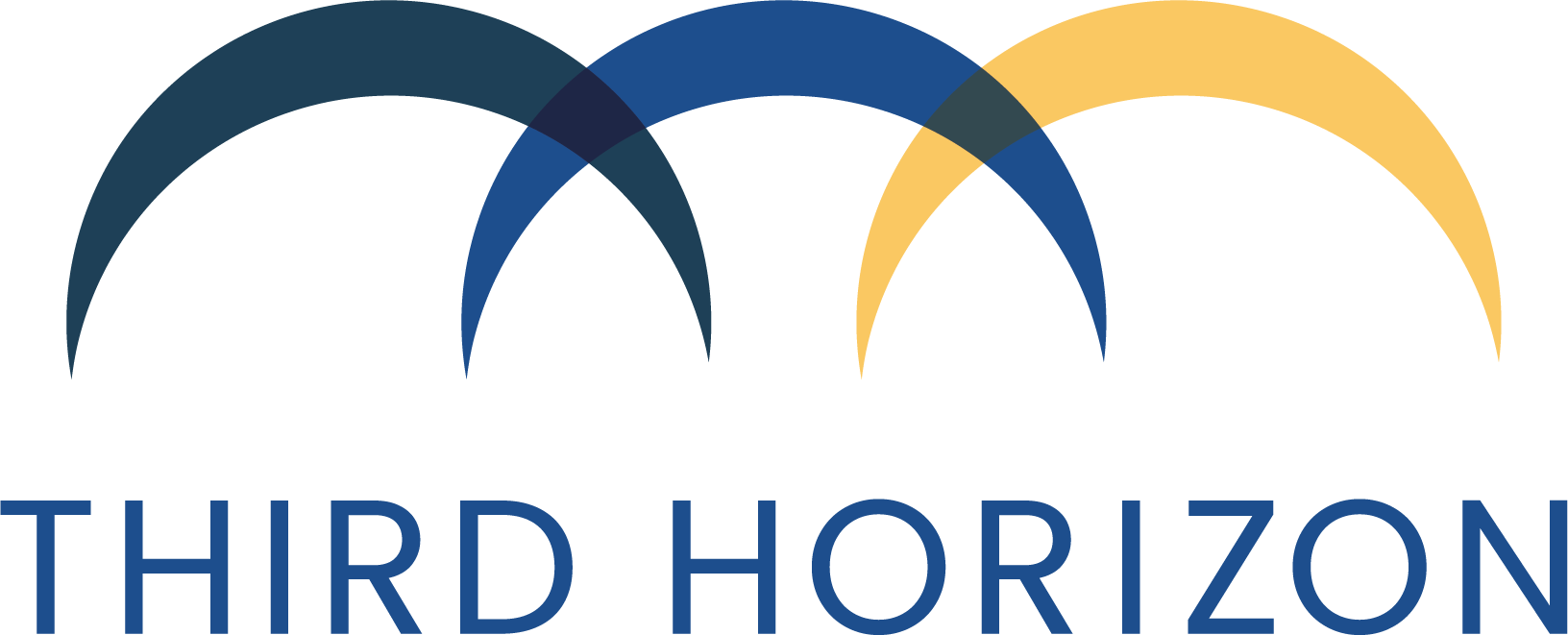You’re reading Third Horizon’s 2025 monthly blog series on health care innovation and resilience. Throughout the year, we will bring our unique perspective to bear across our three advisory areas: Behavioral Health, Community Health, and Payment Design and Analytics.
This month’s focus: How health care organizations can adapt existing investments to align with the Trump administration’s redesigned innovation strategy.
Listen to the article
By Ashley DeGarmo, LSW, Chief Client Officer; Andy Wilson, PhD, Managing Director for Analytics; and Topher Rasmussen, MSW, Communications Manager
On May 13, 2025, the Centers for Medicare & Medicaid Services (CMS) Innovation Center (CMMI) hosted a webinar and released supporting materials announcing their new strategy under the “Make America Healthy Again” initiative. This announcement follows changes made two months prior, when CMMI terminated four alternative payment models (APMs), reduced the size of one, and canceled two previously planned models. These decisions provide important tea leaves as to where the center may emphasize resources over the next several years.
From System Transformation to Individual Empowerment
Established in 2010, CMMI has actively developed APMs such as Bundled Payments for Care Improvement (BPCI), Comprehensive Primary Care, and the ACO REACH Model. These APMs represent payments for health care services that seek to counteract traditional fee-for-service incentives, supporting the movement to value-based care that pays for outcomes rather than volume. Like many health care policies and initiatives, the public sector, particularly CMMI, has been an important driver of APMs.
Over the past 15 years, CMMI has positioned states, payers, health systems, and providers as catalysts for change. However, the center’s new strategic direction indicates a pivot from the previous administration’s system-level transformation approach to individual empowerment and prevention.
Understanding the Strategic Reversal
The Biden administration’s 2021-2024 CMMI strategy focused on five strategic objectives:
- Drive accountable care
- Advance health equity
- Support care innovations
- Improve access by addressing affordability
- Partner to achieve system transformation
This approach emphasized health equity, multi-payer alignment, and broad health care transformation with explicit attention to addressing social determinants of health.
The new “Make America Healthy Again” strategy has reoriented around three different pillars:
- Promote evidence-based prevention
- Empower people to achieve their health goals
- Drive choice and competition for people
These are underpinned by a foundational principle to “protect the federal taxpayer” rather than the previous focus on system-wide transformation and stakeholder alignment.
Reallocation Rather Than Retreat
While some initially interpreted the termination of CMMI programs as signaling lukewarm commitment to value-based care, the reality appears to be that the administration viewed these programs as ineffective and misaligned with its priorities. Of the ending programs, one is transitioning to a new model, while two others were already scheduled to conclude within the next two years.
This strategic reset represents a shift in focus rather than a wavering commitment to innovation and emphasizes collaboration with the private sector to drive health care transformation. Combined with the commitment to shifting towards value-based care, CMMI has the opportunity to test new types of models with unique features.
Opportunities through the Three Strategic Pillars
1. Promote Evidence-Based Prevention
The goals under this pillar look upstream to avoid disease and better manage people’s care. Potential approaches include:
- Payment for outreach and engagement: Traditionally, CMS has only reimbursed for services related to direct patient care. The provider or other groups, such as community-based organizations, have born any outreach efforts. Models focused on reimbursing for outreach and engagement activities, as well as primary care touchpoints, could help advance greater uptake of preventive services and chronic disease management.
- Reintegrating outreach: Much outreach and engagement activity has been pushed to managed care entities. These shifts have weakened patient engagement during critical intervention times. Using financial incentives to encourage provider- and community-based outreach and health promotion activities can help build patient relationships and create sustainability for these costs.
- Multi-payer alignment for prevention: A grave challenge in prevention is the transient nature of how long an individual remains under the same health insurance payer. Prevention efforts have a longer tail impact on cost savings and may yield a sufficient return on investment for the current payer. To overcome this, CMMI should emphasize multi-payer alignment as part of its strategy to advance prevention, ensuring incentives are similar across all payers, public and private.
2. Empower People to Achieve Their Health Goals
The advent of wearables and other remote monitoring tools, along with increased access to data, has shaped how individuals view their own health. This area presents natural opportunities for public-private partnerships:
- Leveraging consumer health technology: The private market creation of wearables such as Fitbit and Apple Watches collects substantial health data, activating consumers’ behaviors and actions. However, the current state does not allow or incentivize providers to use this data in patient care.
- Infrastructure investment: It is not unprecedented for CMMI to set up payment models that support infrastructure development. CMMI could allow for payment to invest in infrastructure to ingest consumer health data into EMRs or EHRs, provider support staff to address patients’ needs, and the actual devices for patients.
- Ensuring equitable access: By ensuring equitable access to these consumer tools, CMMI could ensure their served populations can benefit from these innovations while addressing potential disparities.
3. Drive Choice and Competition
Key components of driving choice and competition include:
- Promoting transparency: Transparency in Coverage regulations, finalized in 2020 and implemented in phases beginning in 2022, required payers to post all contracted rates between providers.While these files are not available for Medicare Advantage or Medicaid managed care, CMMI can continue to promote greater transparency in health care, eventually supporting similar requirements for these plans. Greater transparency will promote better patient decision-making but also improve APM design and benchmarking.
- Standardizing quality measures: Creating and implementing standard measures that predicate incentive payments will increase provider and payer efficiency and allow more transparency for consumer choice. However, CMMI must acknowledge that not all measures align with all payment model objectives. For instance, the Innovating Behavioral Health Model will have different measures than a Joint Replacement Model.
- Streamlining administrative burdens: Most programs are designed with their own unique features and rules. Rarely have programs attempted to align in terms of key design features and elements. Where possible, standardizing APM designs and methodologies to ease administrative burden will further enhance the adoption of value-based payment approaches.
- Broadening APM reach: With some exceptions, most participants in CMMI programs as well as APMs more broadly have been large integrated health systems and affiliated provider groups. Models designed to encourage participation among other types of providers, such as independent providers groups or health centers, will help APMs and value-based care further permeate across the health care delivery system. However, models that increasingly impose downside risk, as CMMI’s new strategy emphasizes, will need to ensure adequate protections are in place to soften the impacts of potentially large financial losses that may result.
Implications for Health care Organizations
Shifting strategic approaches is common during administration changes and can, at times, feel disorienting, but the shift also presents opportunities for organizations that can quickly adapt. Consider the following approaches to navigate this transition:
1. Reframe Existing Investments
Rather than abandoning previous investments, reframe them within the new strategic context:
- Data analytics infrastructure: Systems built for population health management can be repurposed to support individual patient engagement and prevention initiatives.
- Disease management programs: Programs developed for accountable care can focus on evidence-based prevention and patient empowerment through a population health framework.
- Provider networks: Networks developed for ACOs can be leveraged to enhance patient choice and competition.
2. Focus on Prevention ROI
The emphasis on prevention creates an opportunity to demonstrate return on investment in different terms:
- develop metrics that capture the value of preventive services in terms of avoided costs and improved outcomes
- identify prevention-focused interventions that can generate near-term savings for both patients and payers
- create dashboards that track patient engagement with preventive services and the resulting outcomes
3. Enhance Patient Empowerment Tools
With the shift toward individual patient empowerment, organizations should:
- evaluate options to integrate consumer health technology data into clinical workflows
- develop platforms that help patients understand their own health data and make informed decisions
- create transparent information about costs and quality to support patient choice
4. Navigate the Competitive Landscape
As CMMI shifts toward a more competition-focused approach, organizations should:
- assess their competitive positioning in terms of quality, accessibility, and cost
- identify opportunities to support independent providers through partnerships that preserve their autonomy
- evaluate how they can compete more effectively in a more consumer-driven market
- understand their readiness to participate in APMs and take on downside risk
Conclusion
While early signs of model termination felt ominous, CMMI’s new plan explicitly commits to advancing value-based care. Under this new approach, proposals for innovative payment models may need to demonstrate commitment to patient empowerment and financial sustainability.
At Third Horizon, we remain committed to advancing value-based care and have always believed in financials as a key lever in system design. We encourage states and providers engaging in CMMI models to apply these pillars critically to model design. Health care organizations are no stranger to agility and strategic reframing. Those who can quickly adapt existing investments to support evidence-based prevention, patient empowerment, and informed choice will be best positioned to succeed in this new landscape.
While the strategic direction has changed dramatically, the underlying goal remains the same: improving health care value. Organizations navigating this transition while maintaining operational stability will find opportunities to thrive under the “Make America Healthy Again” initiative, even as they preserve valuable aspects of previous transformation efforts.


